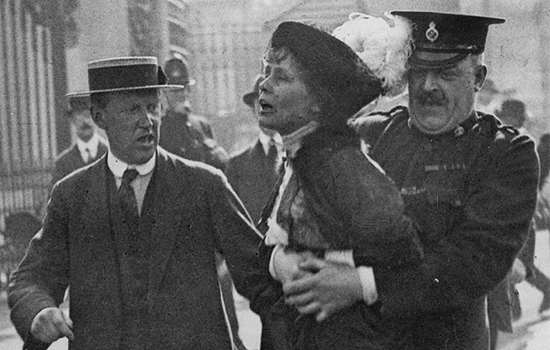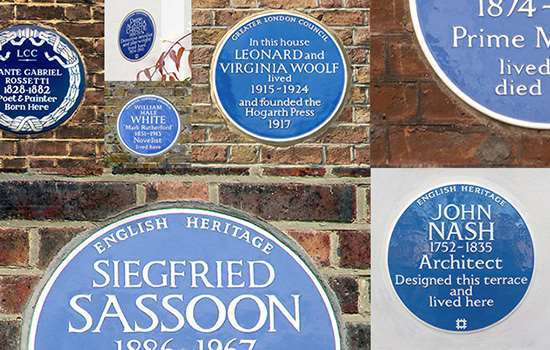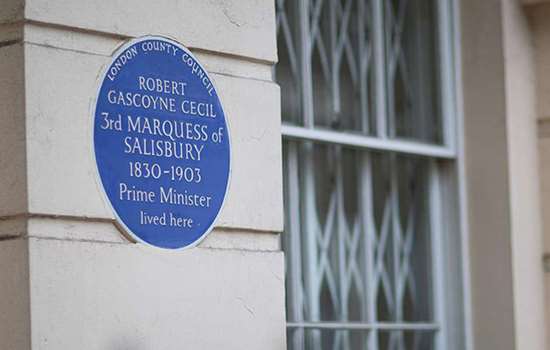Enid Marx (1902–1998)
Plaque erected in 2022 by English Heritage at 39 Thornhill Road, Barnsbury, London, N1 1JS, London Borough of Islington
All images © English Heritage
Profession
Pattern designer, illustrator and artist
Category
Applied Arts, Fine Arts
Inscription
ENID MARX 1902–1998 Pattern designer, illustrator and artist lived and worked here from 1965
Material
Ceramic
The influential artist and designer Enid Marx is commemorated with a blue plaque at 39 Thornhill Road, where she lived and worked for more than 30 years. Her most notable work includes the 1937 commission to design the seating fabric for the London Underground and the 1953 design for postage stamps marking the start of Queen Elizabeth II’s reign.
Education and early career
Enid Dorothy Crystal Marx was born in north London on 20 October 1902, the youngest of three children of Robert Joseph Marx and Annie Marie, née Neuberger. Her father was an inventor, engineer and manufacturer.
After education at South Hampstead High School and Roedean School in Sussex, where her artistic talent was encouraged, Enid Marx attended the Central School of Arts and Crafts for a year before moving in 1922 to the Royal College of Art. There she was part of what Paul Nash (briefly a tutor there) famously described as an ‘outbreak of talent’ which included Henry Moore, Edward Bawden and Eric Ravilious. Marx failed her final diploma, possibly because of the abstract tendencies in her exhibition piece. In 1925 she began to work as a pattern designer and printer.
Marx – Marco to her friends and colleagues – was immediately successful and her woodblock-printed textiles, wood engravings, linocuts and pattern papers were well received. Nash introduced her to the Curwen Press, which in 1925 commissioned her characteristic small-scale repeating patterns for book covers and lining papers. Her very first design was widely used by various publishers. From 1927 she had her own large design studio, textile printing shop and showroom.
Textile design
During the 1930s Marx’s textiles achieved high visibility and acclaim. Hand-printed with her characteristic rhythmically repeating geometrical patterns, they were intended as furnishing or dress fabrics for avant-garde connoisseurs.
In 1937 Enid Marx was one of five designers selected to design the seating fabric for the London Underground. The fabric was to be a hard-wearing, dirt-resistant moquette (a woven fabric with cut and uncut areas) and the designs had to look cheerful and solid, while using a limited range of colours. Five of her designs went into production. This was a turning point in Marx’s career, and she gave up block printing on textiles, turning instead to designing for industrial production.
In 1943 Marx was recruited as the textile expert for the wartime Utility Scheme; 30 of her own textile designs went into industrial production. She relished the challenge of creating attractive and lively patterns that were simple in design and cheap to manufacture.
Other work
After the war Marx continued to design for industrial production but also increased her output of book illustrations, pattern papers and jacket covers. Her most visible work was the 1953 design for postage stamps for the new queen’s reign. Marx was responsible for the lowest – and hence most used – denominations. In the 1940s she also began to write and illustrate children’s books, including Bulgy the Barrage Balloon (1941), which sold out its first edition of 5,000 and was reprinted.
Since childhood Marx had loved popular art, a passion shared with her friend and lifelong companion, Margaret Lambert, a historian of 20th-century European politics, whom Marx had met in the early 1930s. In 1937 Marx designed the jacket for Lambert’s When Victoria Began to Reign. Lambert and Marx co-authored English Popular and Traditional Art in England (1946), which they expanded into English Popular Art (1951).
Popular art also inspired Marx’s own work, which often featured animal subjects. In 1957 the London Zoo adopted two of her prints for their posters. Her final children’s book, Sam and Arry (1972), featured her own beloved Siamese cats.
Thornhill Road
For many years Enid Marx and Margaret Lambert maintained a flat on the Finchley Road in St John’s Wood as their London residence, although they spent time in Exeter and Scotland for Lambert’s teaching. In the early 1960s Lambert bought 39 Thornhill Road, Islington, a mid-19th-century three-storey house, which she shared with Marx, her friend Eleanor Bruening, and Lambert’s sister Grace.
Marx remained at number 39 for more than 30 years, until her death on 18 May 1998. She lived and worked in what was known as the ‘mews cottage’, a self-contained renovation or replacement of the original carriage house abutting the right-hand side. She also had a purpose-built studio in the back garden. Although while she lived here she was not as high profile in her design work as she had been during the 1930s and 1940s, she remained active in the world of design and committees, and from the 1970s onwards enjoyed a revival of her and her contemporaries’ work and influence.
Nearby Blue Plaques
More About Blue Plaques



